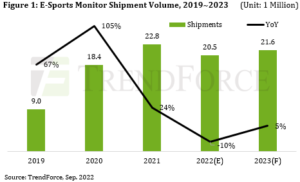Gaming Monitor Market Faces Inaugural Downturn with 2022 Shipments Downgraded to 20.5 Million Units, Says TrendForce
According to the latest TrendForce research, shipments of gaming monitors are in decline for the first time since the product category was launched to market, with 2022 estimates lowered to 20.5 million units, a 10% drop YoY. The primary reasons for this downgrade are intensifying inflation in Europe and spiking interest rates in North America which have upset and displaced demand for consumer electronics products. In addition, delays in launching high-end graphics cards has also led some e-sports consumers to consider postponing purchases.
According to TrendForce, judging from the market share of flat and curved gaming monitors, curved gaming surfaces accounted for approximately 41% of the market in 2021. In 2022, this share will increase to 44% and is expected to have a chance to reach 46% in 2023. In addition to an increased supply of curved monitor panels and their high price-performance ratio, growth in the market share of Ultra-Wide products is also one of the reasons for the rise of curved products.
In terms of gaming monitor panel types, VA accounted for approximately 48% of shipments in 2021, IPS was next at 43%, and TN captured 9%. In 2022, the market share of TN will continue to shrink and it is estimated at only 4%, while VA will have the opportunity to soar to 52% as long as panel pricing is competitive. It is worth mentioning, after Samsung Display (SDC) launched QD-OLED and LG Display (LGD) launched White OLED e-sports monitor panels, OLED e-sports products began to emerge in 2022 and its market share is expected to reach 0.4% this year. In addition, monitor brands have successively joined in the launch of OLED products and the market share of this category is expected to reach 2% in 2023.
Looking forward to the gaming monitor market in 2023, if the types of panels supplied and models launched by brands continue to diversify while the overall LCD monitor market shrinks as expected, there will still be opportunities to maintain shipment growth. TrendForce believes that the M-type product strategy will help the gaming monitor market to grow against trend. First of all, low-end gaming products will be made more affordable by lowering specifications and costs, narrowing the price differential between these products and general-use monitors. In addition, a 100Hz product line can be added to replace the preceding 75Hz e-sports market. The high-end market continues to develop e-sports products featuring new technology such as QD-OLED, OLED, and Mini LED, while simultaneously enhancing consumers’ user experience to focus consumers on e-sports products when purchasing monitors and promote e-sports monitor market share.











